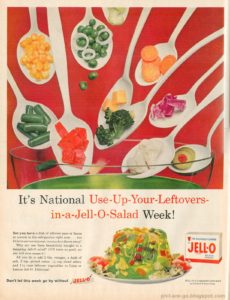 Mrs. T and I dined the other night at a “gastropub” (a neologism I dislike intensely, but we seem to be stuck with it). One of the dishes that I ordered was a salad whose constituent parts included strawberries, dried apricots, goat cheese, lightly salted Marcona almonds, and a raspberry vinaigrette. As I nibbled on an almond, I found myself thinking of the salads of my childhood, which more often than not consisted of dead-tired tomatoes and iceberg lettuce slathered in Thousand Island dressing, and marveled for the umpteenth time at how much America has changed since I was a boy.
Mrs. T and I dined the other night at a “gastropub” (a neologism I dislike intensely, but we seem to be stuck with it). One of the dishes that I ordered was a salad whose constituent parts included strawberries, dried apricots, goat cheese, lightly salted Marcona almonds, and a raspberry vinaigrette. As I nibbled on an almond, I found myself thinking of the salads of my childhood, which more often than not consisted of dead-tired tomatoes and iceberg lettuce slathered in Thousand Island dressing, and marveled for the umpteenth time at how much America has changed since I was a boy.
Having enjoyed a (mostly) happy childhood, I now spend a fair amount of time thinking such thoughts. While I think them with a proper detachment, I can’t help but feel nostalgic for the way things were in the Sixties, the days of the New Frontier. Life really was simpler then, and the choices a small-town boy made each day were both fewer in number and less challenging. Not knowing any better, I was rarely dissatisfied with the alternatives on offer.
Here are a few of them:
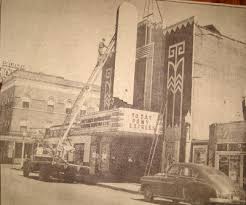 • Smalltown, U.S.A., had two movie theaters, each of which had one screen. The Malone, the respectable one, was where I saw my first movie in 1961. The smaller Rex Theatre showed “dirty” movies, though it flirted with more ambitious fare: it was there that I saw 2001: A Space Odyssey and Franco Zeffirelli’s screen version of Romeo and Juliet. I knew nothing of revival houses until I moved to Kansas City in the mid-Seventies. Until then I’d seen no “old” movies save for The Wizard of Oz, not even the ubiquitous Casablanca. Such films were never shown on KFVS, WPSD, or WSIL, the three stations that we got in Smalltown, and home video had yet to be invented.
• Smalltown, U.S.A., had two movie theaters, each of which had one screen. The Malone, the respectable one, was where I saw my first movie in 1961. The smaller Rex Theatre showed “dirty” movies, though it flirted with more ambitious fare: it was there that I saw 2001: A Space Odyssey and Franco Zeffirelli’s screen version of Romeo and Juliet. I knew nothing of revival houses until I moved to Kansas City in the mid-Seventies. Until then I’d seen no “old” movies save for The Wizard of Oz, not even the ubiquitous Casablanca. Such films were never shown on KFVS, WPSD, or WSIL, the three stations that we got in Smalltown, and home video had yet to be invented.
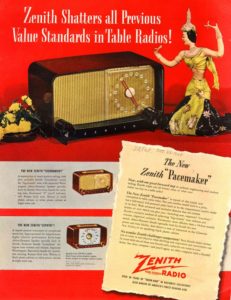 • My mother made breakfast for our family every morning, listening to Paul Harvey News and Comment on a Zenith table-top radio (or was it a Philco?) as she did so. It aired on KSIM, one of only two radio stations that we could pick up in Smalltown. In those days it was an ABC affiliate that played top-40 hits. Now it’s an all-news station on which Rush Limbaugh, the Paul Harvey de nos jours, can be heard in the afternoons. KRHW, Smalltown’s other station, plays country music.
• My mother made breakfast for our family every morning, listening to Paul Harvey News and Comment on a Zenith table-top radio (or was it a Philco?) as she did so. It aired on KSIM, one of only two radio stations that we could pick up in Smalltown. In those days it was an ABC affiliate that played top-40 hits. Now it’s an all-news station on which Rush Limbaugh, the Paul Harvey de nos jours, can be heard in the afternoons. KRHW, Smalltown’s other station, plays country music.
Most of the locals, though, don’t listen to either station anymore, be it in their kitchens or their cars. Like the rest of the world, they’ve largely given up on terrestrial radio, opting instead for CDs or, increasingly, streaming.
• I spread margarine, not butter, on my breakfast toast and dinner rolls. My mother never bought butter at the grocery store. The only time I ever had it was in pre-packaged pat form when we went out to eat, which my family did most Saturday nights. The restaurant I remember best, the Charcoal House, served steaks, pork chops, fried chicken, fried fish, and hamburgers. Three-quarters of the restaurant meals I ate as a boy—probably more—included one of these five entreés. When we had pizza, my mother made it from out of a box. If anybody ever ordered anything else for dinner at a restaurant in my neck of the woods, I can’t recall it. (Possibly spaghetti, but that, too, was a dish more typically eaten at home or school.) Store-bought Chinese food was a rarity reserved for trips to the big city. Otherwise we settled for La Choy in a can, and were glad to get it.
 • The first McDonald’s I ever saw opened in the summer of 1968 in Cape Girardeau, a town located a half-hour north of us. The menu consisted of nine items, five of them beverages. My father sometimes took us there instead of a “real” restaurant. Far from being disappointed, my brother and I thought it a privilege.
• The first McDonald’s I ever saw opened in the summer of 1968 in Cape Girardeau, a town located a half-hour north of us. The menu consisted of nine items, five of them beverages. My father sometimes took us there instead of a “real” restaurant. Far from being disappointed, my brother and I thought it a privilege.
• Coca-Cola came in glass bottles or out of a tap in the Sixties, and there was only one flavor: Diet Coke didn’t come along until 1982. (If you wanted a cherry Coke, you went to a soda fountain.) It was, like our trips to McDonald’s, a special treat, not something a growing boy was permitted to drink every day. Perhaps as a result, I loved it–and still do, truth to tell, though of late I’m more inclined to prefer Polar Seltzer, which suits my mature palate better.
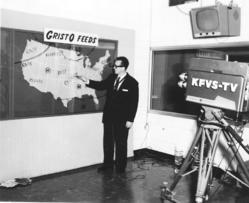 • Since the VCR was as yet a pipe dream, all TV was “appointment” TV in the Sixties. You watched shows when they aired, when they were rerun in the summer, or not at all. We did, however, have two TV sets, a Curtis Mathes cabinet model in the living room and a black-and-white portable in the kitchen (my father was a hardware salesman, so he got a deal on it). This meant I could watch a different show when I wanted to see something in which my parents weren’t interested, so long as it was on CBS or NBC. WSIL, the ABC affiliate, was in Harrisburg, Illinois, a town so far away that the residents of Smalltown could only pick it up with a rooftop antenna. The “rabbit-ear” antennas that stuck up from the back of our portable set wouldn’t do the job, no matter how much you fiddled with them.
• Since the VCR was as yet a pipe dream, all TV was “appointment” TV in the Sixties. You watched shows when they aired, when they were rerun in the summer, or not at all. We did, however, have two TV sets, a Curtis Mathes cabinet model in the living room and a black-and-white portable in the kitchen (my father was a hardware salesman, so he got a deal on it). This meant I could watch a different show when I wanted to see something in which my parents weren’t interested, so long as it was on CBS or NBC. WSIL, the ABC affiliate, was in Harrisburg, Illinois, a town so far away that the residents of Smalltown could only pick it up with a rooftop antenna. The “rabbit-ear” antennas that stuck up from the back of our portable set wouldn’t do the job, no matter how much you fiddled with them.
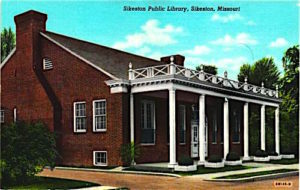 • I went every Saturday afternoon to the Smalltown Public Library, to which I started bicycling as soon as my parents thought me old enough to go by myself. It was a handsome building of modest proportions with a limited number of titles from which to pick the coming week’s leisure-time reading. But it was, along with network TV, my first window on the world beyond Smalltown, and so I reveled in every visit, invariably checking out three books—the maximum allowed—each time I went there. Sometimes I actually propped up a book on the handlebars of my bicycle and started reading it on the way home. This horrified my mother, with good reason. It’s a wonder I didn’t kill myself.
• I went every Saturday afternoon to the Smalltown Public Library, to which I started bicycling as soon as my parents thought me old enough to go by myself. It was a handsome building of modest proportions with a limited number of titles from which to pick the coming week’s leisure-time reading. But it was, along with network TV, my first window on the world beyond Smalltown, and so I reveled in every visit, invariably checking out three books—the maximum allowed—each time I went there. Sometimes I actually propped up a book on the handlebars of my bicycle and started reading it on the way home. This horrified my mother, with good reason. It’s a wonder I didn’t kill myself.
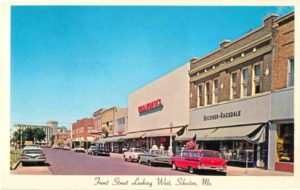 • All of the clothes that I wore as a boy came from two chain stores, Sears and J.C. Penney’s, and two locally owned stores, Buckner-Ragsdale and Falkoff’s (the second of which, I rejoice to report, is still in business). Except for Levi’s and Stetson hats, clothing brands were unheard-of back then, at least in southeast Missouri. I wore what my mother bought, and did so without complaint.
• All of the clothes that I wore as a boy came from two chain stores, Sears and J.C. Penney’s, and two locally owned stores, Buckner-Ragsdale and Falkoff’s (the second of which, I rejoice to report, is still in business). Except for Levi’s and Stetson hats, clothing brands were unheard-of back then, at least in southeast Missouri. I wore what my mother bought, and did so without complaint.
It goes without saying that postmodern America offers its residents, even those who live in places like Smalltown, U.S.A., an overflowing cornucopia of cultural possibilities so wide-ranging that we take for granted the quotidian miracle of what Bruce Springseen too casually dismissed as 57 channels and nothin’ on. Most of these possibilities delight me beyond the wildest dreams of my childhood: I can scarcely imagine life without old movies or downloadable music, and while I could certainly do without Marcona almonds in a pinch, I’m glad to have them as well. Except when I loathe it, I revel in the present.
Strange, then, that to think of such homely things as Coca-Cola in a glass bottle or a shopping trip to Sears should now bring tears to my eyes. I guess that’s what it means to grow old.
UPDATE: Regarding the entrées available in small-town restaurants, a reader writes:
Shrimp (battered and fried). The other thing that was always on the menu, and which I often ordered.
How could I possibly have forgotten fried shrimp?
* * *
A 1958 TV commercial for Imperial margarine:
Mary Chapin Carpenter sings “I Am a Town” on American Music Shop in 1991:
